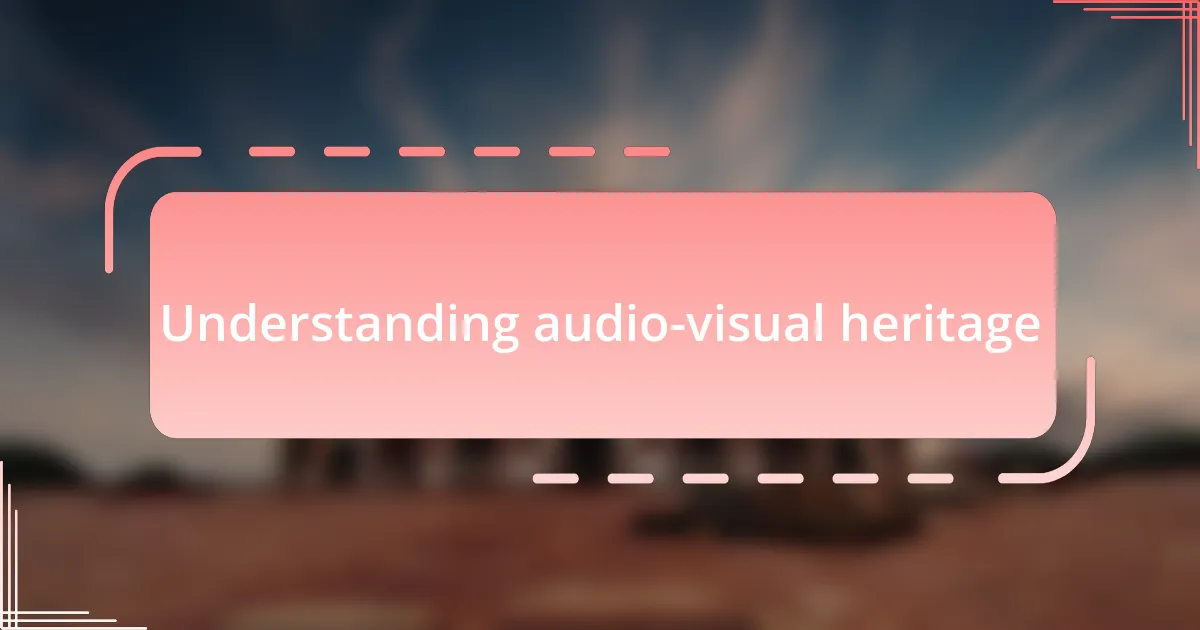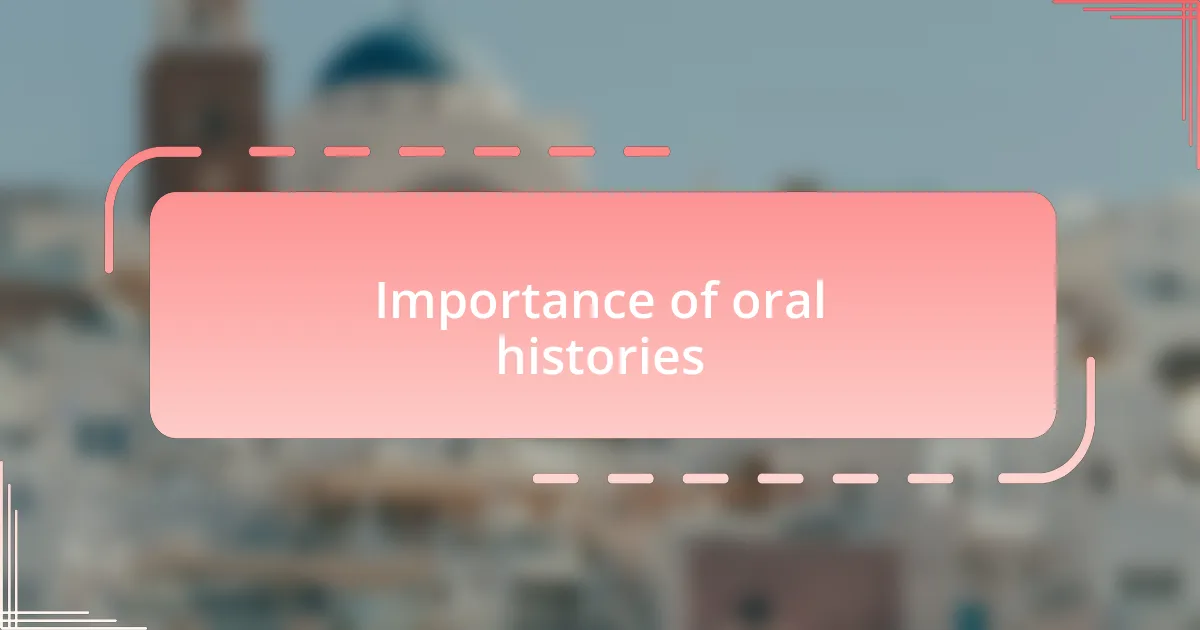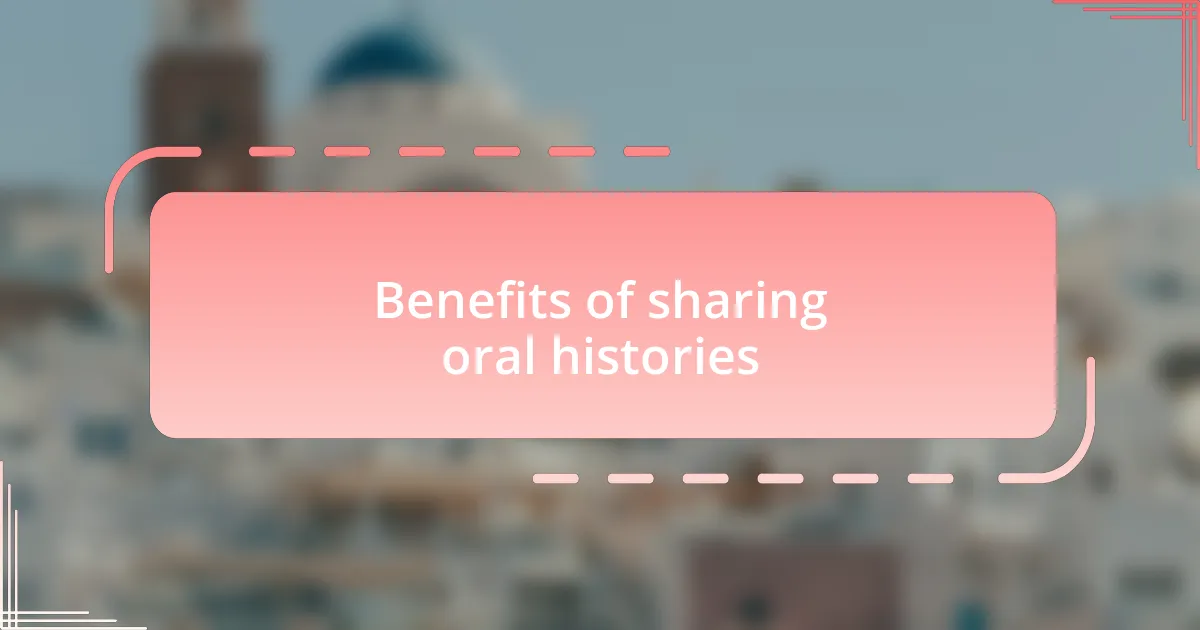Key takeaways:
- Audio-visual heritage connects communities to their past, fostering understanding and shared cultural narratives.
- Oral histories offer personal insights that enrich collective knowledge and strengthen community bonds.
- Preserving and sharing stories through various mediums enhances emotional connection and cultural identity.
- Encouraging community participation in preservation initiatives nurtures pride and ownership among individuals, fostering a vibrant legacy.

Understanding audio-visual heritage
Audio-visual heritage is more than just a collection of old films and recordings; it embodies the stories, emotions, and cultural identities of a community. I often find myself mesmerized by how a simple audio clip can transport me back to a moment in time, evoking feelings I thought were long forgotten. Have you ever listened to a family recording and felt that familiar warmth wash over you? It’s in these instances that the powerful connection between audio-visual materials and our personal histories truly shines.
Consider the impact of visual storytelling. Each frame in a documentary not only captures moments but also reflects societal values and historical contexts. I recall watching an archive film that showcased everyday life from decades ago; the clothes, the music, the nuances in behavior – each element painted a vivid picture of who we were as a society. In these artifacts, we find not just entertainment but a tapestry of our shared human experience.
When we engage with audio-visual heritage, we are participating in a continuous dialogue with the past. Each piece we preserve serves as a bridge, linking generations and fostering understanding. I’ve felt this connection deeply when sharing archival footage with younger family members; their eyes light up with curiosity and wonder. Isn’t it fascinating how these materials can spark conversations that educational textbooks often miss? This dialogue is vital—arguably, it’s what makes audio-visual heritage so essential to our collective memory.

Importance of oral histories
Oral histories hold immense importance as they serve as the living memory of communities, capturing personal experiences that formal documents often overlook. I remember sitting in my grandmother’s living room, listening intently as she recounted stories of her childhood during the war. Each tale carried emotional weight, illuminating not just her life but the broader societal struggles of our family. Have you ever realized how a simple story can shift your perspective on historical events?
These narratives contribute significantly to our understanding of culture and identity. When I record interviews with local elders, I’m often struck by their unique vernacular and expressions, which weave rich cultural tapestries that textbooks can scarcely encapsulate. This form of storytelling not only enriches our heritage but also fosters respect and appreciation for diverse perspectives. Isn’t it compelling how these voices can break down barriers between generations and cultures?
Moreover, oral histories create a sense of belonging and connection. I frequently find myself reflecting on the stories I’ve gathered from various community members—they resonate like an echo, reminding me that my experiences are part of a larger narrative. This sharing of narratives strengthens community bonds and nurtures empathy among individuals. I wonder how many other untold stories are waiting to be uncovered, holding the potential to transform our understanding of the world around us?

Methods for capturing oral histories
One effective method for capturing oral histories is through the use of audio recordings. I remember the first time I brought a portable recorder to a community gathering. The chatter and laughter around me faded as I focused on the voices telling their stories. The clarity of these recordings allows me to revisit the nuances of emotion and tone that can often be lost in written transcripts. How often do we underestimate the power of a person’s voice to convey feelings that words alone might miss?
Another approach I find valuable is conducting video interviews. This method not only preserves the spoken word but also captures facial expressions and body language, adding another layer to the storytelling. I once interviewed a local artist about her journey; watching her animation as she described her creative process made the experience truly immersive. How many times have we seen an emotion on someone’s face that words alone could not express?
Additionally, creating a safe and comfortable environment fosters openness during these interviews. I always try to meet my interviewees in familiar surroundings, like their own homes or favorite cafés. It’s fascinating how a simple change in setting can ease nerves and encourage more profound sharing. Isn’t it amazing how a warm cup of tea and a cozy chair can unlock memories that may have remained hidden?

Tools for preserving audio-visual content
One indispensable tool for preserving audio-visual content is high-quality recording equipment. I vividly recall the first time I invested in a professional microphone. The crispness of the audio made such a difference in capturing the subtleties of a storyteller’s voice. Have you ever listened to a recording that simply didn’t do justice to the moment? That’s where investing in the right gear truly pays off, enabling us to preserve the essence of the stories being told.
For video content, editing software is crucial. I remember painstakingly piecing together interviews, adjusting levels, and adding subtle transitions. It was enlightening to see how the right edits could amplify the emotional impact of a narrative. Isn’t it fascinating how a simple cut can transform a mundane moment into something profound? With the right tools, we can shape the raw footage into a polished piece that resonates with viewers.
Moreover, reliable storage solutions are vital for safeguarding these precious recordings. I learned this lesson the hard way when my external hard drive failed, and I lost some treasured oral histories. Since then, I’ve incorporated cloud storage, which not only offers security but also easy access for future projects. How reassuring is it to know that our collection of voices and stories is safe, ready to be shared with generations to come?

Benefits of sharing oral histories
Sharing oral histories holds immense power in fostering community connection. I recall a local gathering where a neighbor recounted their family’s journey through adversity. The way their voice cracked with emotion brought our community together, creating a shared understanding that transcended individual experiences. Doesn’t it feel rewarding when stories echo our own, helping us feel less alone in our struggles?
Another significant benefit is the preservation of cultural heritage. When we share oral histories, we not only document personal narratives but also capture the essence of traditions that might otherwise fade away. I often think about my grandmother’s stories about her childhood—without her sharing them, those vibrant traditions would be lost to time. Isn’t it fascinating how a simple story can foster pride and continuity in our cultural identities?
Furthermore, these shared narratives can serve as valuable educational tools. I remember using recordings of oral histories in a workshop to illustrate historical events from a personal perspective. The participants were engaged and moved, learning not just facts but feelings and connections to those events. How can we underestimate the impact of a story to transform not just knowledge but empathy in understanding history?

My personal experiences in preservation
In my journey of preserving oral histories, I’ve often found myself in unexpected conversations that deepen my appreciation for storytelling. One afternoon, I visited a local elder who shared tales of their early migrations, every word steeped in nostalgia. Listening intently, I realized how vital these narratives are—they connect us to our roots and illuminate the paths that have shaped our communities.
I distinctly remember a project where I interviewed various community members about their experiences during significant local events. One individual described their feelings of hope and resilience in the face of hardship, their voice full of passion and pain. It struck me how these personal stories, filled with emotion, offered a glimpse into the complexities of human experience, fostering empathy in ways mere facts cannot.
Another memorable instance involved a workshop focused on the art of storytelling. Participants brought objects that held stories—such as a vintage photograph or a handmade quilt—and each narrative enriched the collective experience. Reflecting on this, I pondered how objects serve as tangible bridges to our past, and how preserving these stories allows us to cultivate a shared legacy that feels alive and relevant.

Encouraging community participation in preservation
Encouraging community participation in preservation is often about creating opportunities for dialogue. I recall hosting a public storytelling night at the local community center, where residents were invited to share their memories. It was incredible to see how hesitant individuals blossomed into passionate narrators, illuminating the shared textures of our lives. How many hidden stories lie within our community, waiting to be uncovered?
One approach I’ve found particularly effective is involving schools in preservation projects. I remember collaborating with students to collect stories from their grandparents, who might have been overlooked in larger narratives. It was heartwarming to witness the excitement in the young storytellers’ eyes as they connected with their heritage, fostering a sense of pride and ownership. Isn’t it fascinating how these seemingly simple exchanges can strengthen our community fabric?
Moreover, community events can serve as empowering platforms for sharing these oral histories. During a local festival, we set up a booth named “Story Central,” inviting visitors to record their tales. The feel of those genuine connections reminded me that these narratives are not just personal; they are collective treasures. How can we nurture more spaces where everyone’s voice matters and where each story contributes to the rich tapestry of our history?